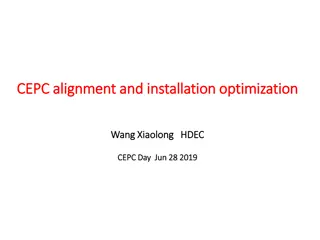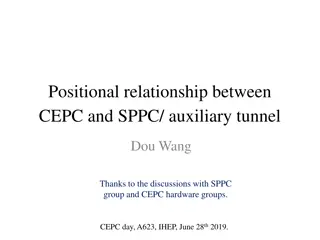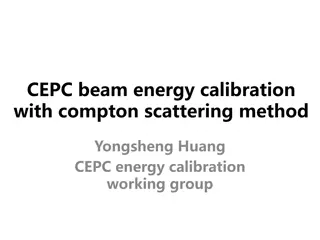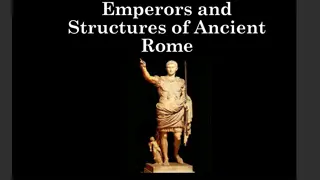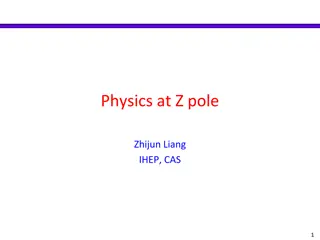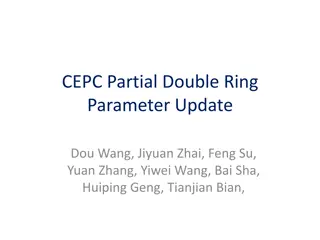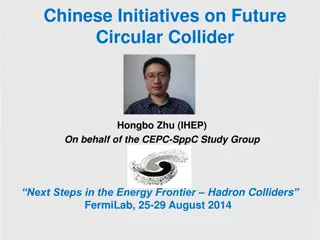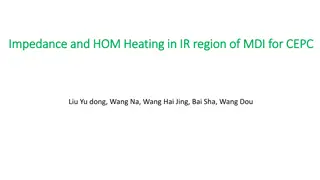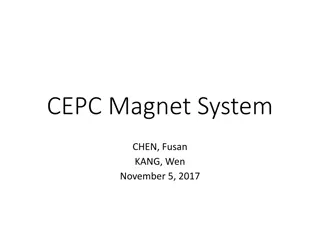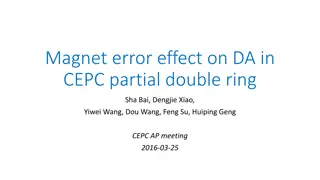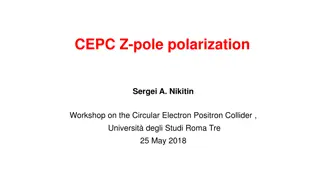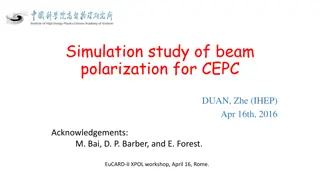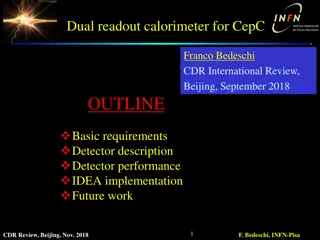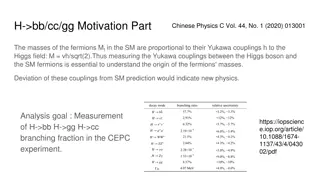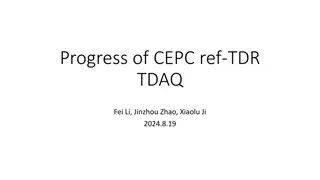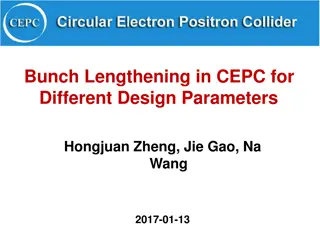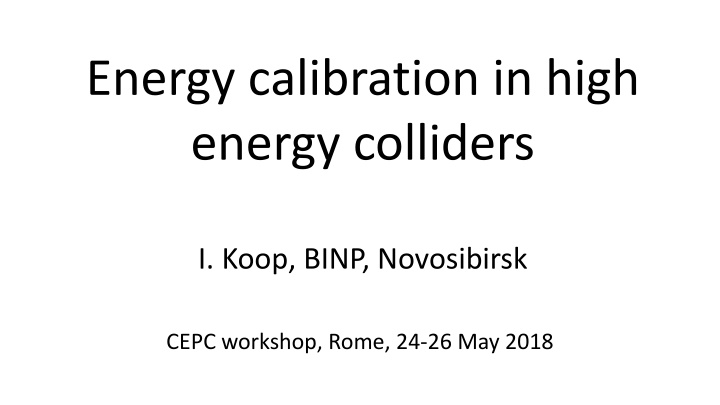
Energy Calibration in High Energy Colliders: Methods and Findings
Explore energy calibration in high-energy colliders through studies on polarization, spin tracking algorithms, and beam emittances. Discover insights on static distortions, longitudinal magnetic fields, and spin motion influences at CEPC and FCCee, along with equilibrium beam polarization simulations. Uncover the significance of parameters like Sokolov-Ternov polarization time and depolarization time in achieving optimal polarization levels.
Download Presentation

Please find below an Image/Link to download the presentation.
The content on the website is provided AS IS for your information and personal use only. It may not be sold, licensed, or shared on other websites without obtaining consent from the author. If you encounter any issues during the download, it is possible that the publisher has removed the file from their server.
You are allowed to download the files provided on this website for personal or commercial use, subject to the condition that they are used lawfully. All files are the property of their respective owners.
The content on the website is provided AS IS for your information and personal use only. It may not be sold, licensed, or shared on other websites without obtaining consent from the author.
E N D
Presentation Transcript
Energy calibration in high energy colliders I. Koop, BINP, Novosibirsk CEPC workshop, Rome, 24-26 May 2018
Outline Polarization study approach Spin tracking code features Self-polarization degree estimations Resonant Depolarization problems Conclusion. I. Koop, CEPC-Rome-2018 2
Polarization specifics of CEPC and FCCee Beam emittances in CEPC/FCCee are so small, that all resonances with the betatron frequencies are suppressed and their influence on the spin motion is negligible: 0 | y | ~ 2 10 5(at E=80 GeV). Therefore, only static vertical orbit distortions and the longitudinal magnetic fields with nonzero integrals can affect the spin motion! Precession frequency modulation by the synchrotron oscillations is most important! The relevant parameter is: = 0 would prefer < 1, means ??as high as possible! LEP1: ??=0.065, = 0.0007 , =1.07 - comfortable for beam energy E=45 GeV! But ??=0.05, = 2.4 for base line parameters of FCC-ee at 80 GeV. ??. One I. Koop, CEPC-Rome-2018 3
Spin tracking code algorithm ??(??) = ?0+ ??? cos ????, with ??=2 k, ?(??) =2 ??(??) Spin perturbation: It is localized at s=0. Random jumps of relative energy deviation are localized also at s=0. Spin precession around the y-axis with = ? = 0(1+ ). Radiation damping of is taken into account! ???- simulates the Depolarizer s Impact y s=0 ?0- simulates effects of orbit distortion The code tracks the regular synchrotron and spin motion inside an arc 0 < ?< 2 as: 2 =0 ??= 2 2 ? 0. 1+ ( ) ?? ? +2 ? +??0 ? ? = ? ? 0 cos(?? )+ p? 0 sin(?? ) ps ? =? ? 0 sin(?? )+ p? 0 cos(?? ) ??0 ?(?)= 0 ? (?) + (?) ps(?) ?? ?(?)= 0 1 +? 0 ? cos(?? )+??? sin(?? ) +p? 0 ?? ??? cos(?? ) ? sin(?? ) 0= ? = ?(GeV) 0.44064846, 0=181.55 at ? = 80 GeV. Resonances at : 0= ? + ? ?? 2+ 2? ??0 I. Koop, CEPC-Rome-2018 4
1. Equilibrium beam polarization degree simulation The equilibrium polarization degree can be calculated as: ? = 92.6(%)/(1 + where ???is the Sokolov-Ternov polarization time, while ????is obtained by the spin tracking code depolarization time. ???????) The harmonic spin matching, if applied as at LEP and HERA, can minimize the strengths of two nearby integer parent resonances. But question: how small they can be made? We rely on data from LEP at 61 GeV, where some polarization level, say about 6%, was observed (see R.Assmann et al. , Spin dynamics in LEP with 40 100 GeV beams , AIP Conference Proceedings 570, 169 (2001); doi: 10.1063/1.1384062). This translates to our estimation of some residual uncompensated spin perturbation: ? = 0.0015, which we will use as a reference value. I. Koop, CEPC-Rome-2018 5
Simulating polarization for LEP at 61 GeV, Qs=0.0833 =138.5 I. Koop, CEPC-Rome-2018 6
Equilibrium polarization for LEP at 61 GeV and Qs=0.02073 Here ? = 0.0015, ??= 0.02073. Dips at high m detunings ? ??disappear! Remarkable that polarization is large near the half-integer spin tune values! Arc serves as Siberian Snake? This agrees well with Eliana s simulations! =138.6 =138.4 =138.3 =138.5 I. Koop, CEPC-Rome-2018 7
FCC-ee Equilibrium polarization degree: 80 GeV and Qs=0.05 =182.4 =182.6 =182.5 I. Koop, CEPC-Rome-2018 8
Polarization dependence on energy diffusion rate Lessons from this study: 1) No strong influence of Qs on the attainable polarization level! 2) Only the value of the beam energy spread is really important. Recommendation given from the LEP experience: ??< 52 ??? is confirmed by these simulations. I. Koop, CEPC-Rome-2018 9
Spin resonance width and new nonstandard RD technique My spin tracking code has revealed dramatic increase of the width of the central resonance line at W threshold for chosen synchrotron tune value: Qs=0.05. With such low synchrotron tune and, subsequently, too high value of the synchrotron modulation index = 0 /Qs=2.4 a width of the central spectrum line becomes very large: = 0.002. This corresponds to E/E= 0.00001. In such situation there is no any sense to scan the resonance monotonically no sharp changes in the polarization degree are expected. More reasonable is to do probing of the depolarization efficiency in few depolarizer s frequency points around the center of a peak then steps in polarization degree became quite visible. This idea was proposed by Alain Blondel and, seems, has been tested at LEP. I. Koop, CEPC-Rome-2018 10
Spectrum of 80 GeV single particle spin motion Spectrum of free spin precession of single particle during 40000 turns. ??=0.05. Central peak =0.481 1-st side-band = 0-Qs I. Koop, CEPC-Rome-2018 11
Zoom of spectrum of single particle spin motion Spectrum of free spin precession of single particle during 40000 turns. ??=0.05. Central peak =0.481 1-st order side-band: = 0- Qs 1-st order side-band: =2 - ( 0+ Qs) 2-nd order side-band: =2 - ( 0+ 2 Qs) I. Koop, CEPC-Rome-2018 12
Spectrum for slightly shifted spin tune {0}=0.41 Mirror symmetric the left and the right wings of the central line with this choice of { 0}. It is better to reduce a possible error in determination of the center of a peak! I. Koop, CEPC-Rome-2018 13
Partial depolarizations by 11 steps in depolarizers frequency The left and the right wings of the central line are asymmetric due to too close proximity of 1-st order synchrotron side-band. This should be accounted when fitting to a model. The presented here fit is symmetric hence not fully correct could be modified. I. Koop, CEPC-Rome-2018 14
Partial depolarizations by steps when {0}=0.4875 The left and the right wings became symmetric with this choice of fractional part of 0. I. Koop, CEPC-Rome-2018 15
Partial depolarizations by steps with Qs=0.075, {0}=0.41 The RD response with Qs=0.075 is 8 times more narrow in comparison with the case Qs=0.05 = 0.00025 I. Koop, CEPC-Rome-2018 16
Spectrum line width scaling law Line shape fitting function: f( )=A 2+( 0)2with parameters: A, , 0 Fit found by the tracking of the line width dependence on the synchrotron motion and beam parameters: 0.000686 182.425 0.000663 2.5 3 0 0.05 ?? = 0.0035 = 0.0035 at E=80 GeV For given accelerator without wigglers the energy dependence is very strong: ~ ?8 because ~?3, 0 ~ E, ~ E Therefore, this effect plays important role only at W threshold and not at Z! I. Koop, CEPC-Rome-2018 17
Conclusion Spin tracking of a motion of a single particle reveals the dependence of the spectrum line width from the synchrotron tune and other beam parameters. This width becomes very large for chosen synchrotron tune Qs=0.05 and standard RD procedure becomes not applicable. The discussed above new RD procedure by steps works well even in cases when a width of the spin resonance became very large. That is just a case with Qs=0.05. Still the accuracy of a method needs to be studied further. Second order terms in orbital motion also contribute to the line width (I.Koop, Yu.Shatunov, in proc. EPAC 1988, Rome, p.738-739). Will be evaluated later on. I. Koop, CEPC-Rome-2018 18
Acknowledgments to: Alain Blondel, Eliana Gianfelice-Wendt and Yuri Shatunov for stimulating discussions! Thank you! I. Koop, CEPC-Rome-2018 19


